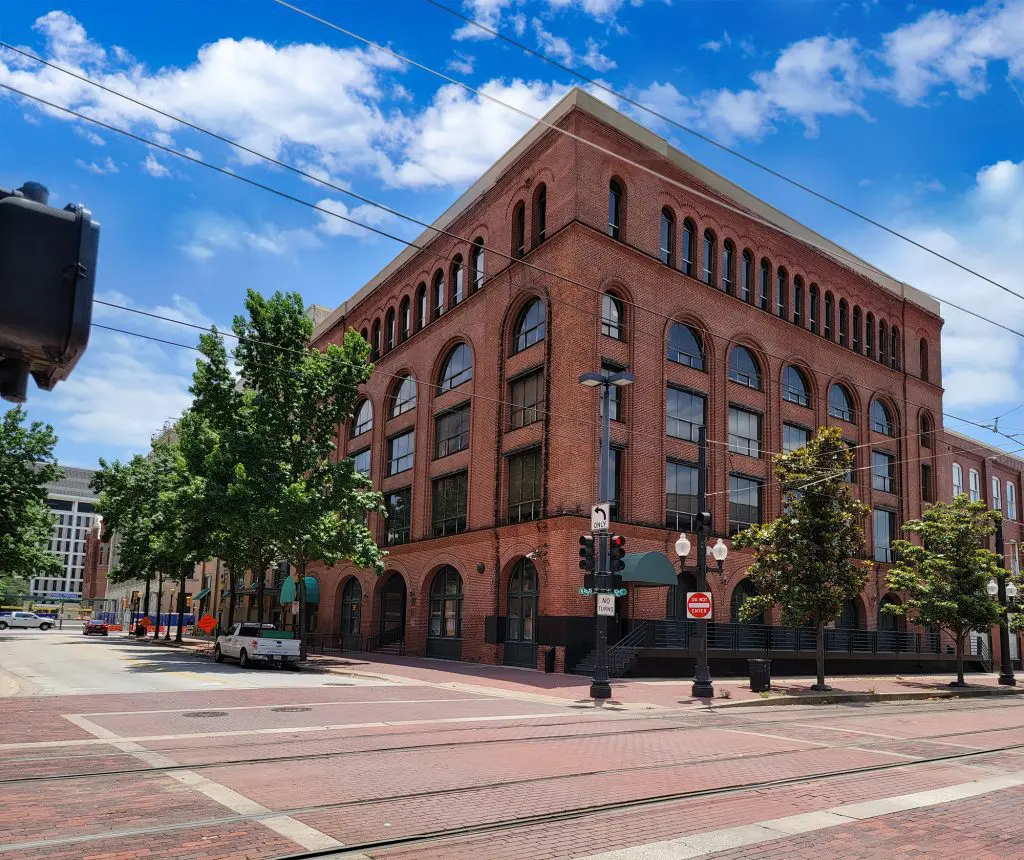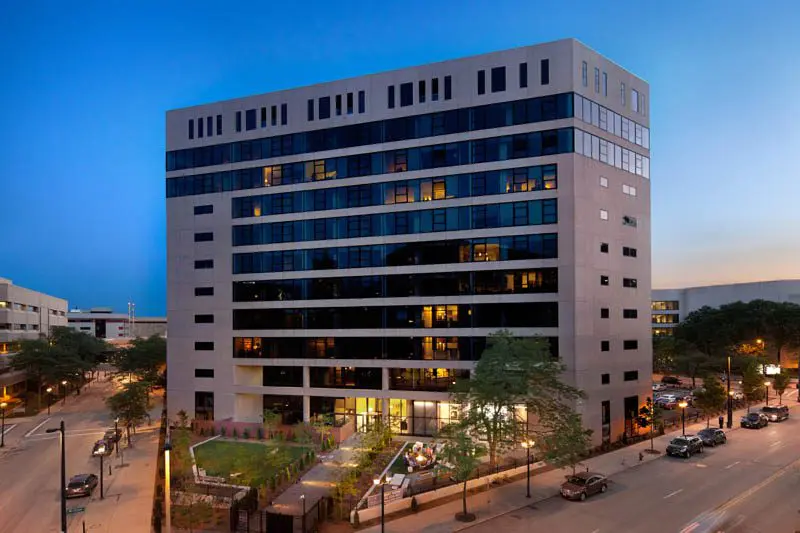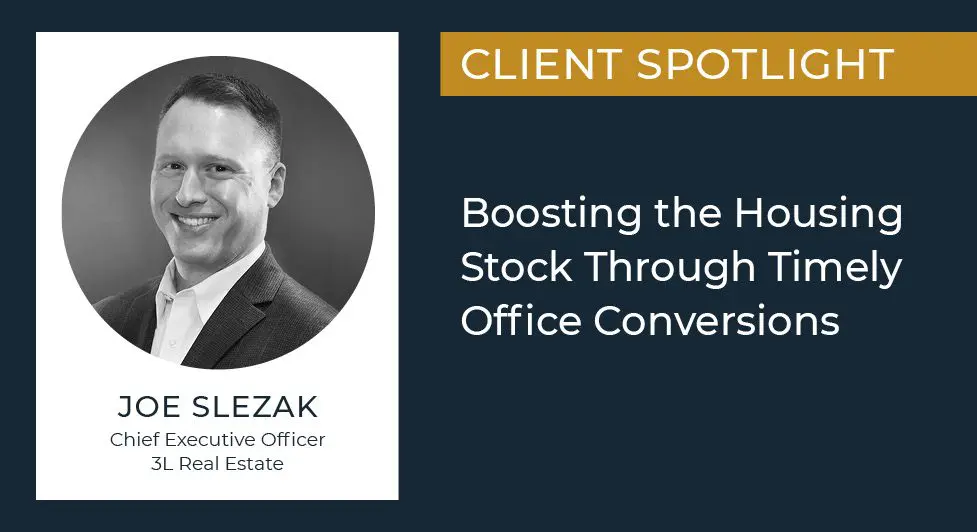More than 20 years before COVID and the rise of remote work, 3L Real Estate’s Joe Slezak was learning the ins and outs of converting underutilized offices and other commercial spaces to affordable, well-appointed market-rate apartments.
Opportunistic value-add plays at the time often amounted to minimal interior upgrades, and so the famed Chicago family owned firm BJB Properties saw an investment gold mine. Slezak, who got his start as an intern at BJB in the late 1990s, rose through the ranks to oversee major financing deals for the family office. In 2015 he went on to launch his own firm—3L Real Estate—and began to expand beyond the Chicago market.
Today, 3L boasts an apartment portfolio of more than 1,500 active units, with 600 more in construction inside of its newest conversion projects. These projects total nearly 2,000,000 square feet in the Chicago, Milwaukee, Dallas, and Fort Worth metro areas. Slezak and his equity partners have invested nearly $100 million of equity to acquire and transform near-vacant properties, encompassing 13 projects totaling $400 million of costs when completed. To date, that portfolio has generated more than $85 million in additional equity, which will grow over $100 million as the current conversion pipeline completes.
“Building housing from the ground up gets even more expensive with inflation and usually has to be luxury in its rent structure to make the mathematics work,” Slezak, 3L’s founding CEO, told Lument.
3L’s experience gives the team a leg up as interest in the adaptive reuse market has increased of late. CBRE projects that the number of office-to-apartment conversions in the U.S. will triple year over year in 2023. Office vacancy rates around the country, meanwhile, could rise more than 50 percent to an estimated one billion square feet of unused space by 2030, per Cushman & Wakefield.
The core of 3L’s properties, which are tailored for high-density areas, have hotel-like features such as large common areas, including lounges and game rooms. The converted buildings accommodate residents looking for accessibility and convenient commuting to and from various downtowns. Most of the properties are close to public transportation that provides a lifeline to local corporations, universities, hospitals.
3L’s in-house team is co-led by COO Sean Story and CFO Benjamin Ehnat and includes Chief Capital Officer John Doubleday—also an original investor.
Slezak sat down with Lument to talk about the rise of adaptive reuse, his firm’s investment strategy, and where he sees opportunity to create more housing in 2023.
Lument: You and your team at 3L have a conversion project in the works in Milwaukee. Can you quickly walk us through that one?
Slezak: Our project in Milwaukee is smaller and in a great spot close to our other projects. It’s a simple rectangle with a courtyard and a lightwell, so we can get units on both sides of the building. It had been owned for a long time by a father who passed it on to his children. They started losing tenants as a result of the pandemic and did not want to go through reinvesting in the building to try to pick it back up when the market rebounded. For us, it’s the prototypical candidate: It’s on its way to becoming vacant and allows for the conversion process to go forward without a huge amount of risk.
Lument: The other project you recently started involves the conversion of the historic Fort Worth National Bank building into rental apartments. What’s unique about that one?
Slezak: This is a property we just acquired so we’re not as far into the conversion process. It’s an office building that had a utility company as its anchor tenant for the last 20 years. The tenant decided not to renew its lease after getting a better deal across the street during COVID and the ownership really had no plan to fill back in 80 percent of the building. So here was this big block of space ready to change. It lays out smartly as a “T” and the elevated cores, stairwells, and windows can all be utilized as is. Fort Worth has the right jurisdiction and zoning components for our model as well. With this project, we were able to utilize historic tax credits that helped bridge the gap on the risk factors involved with higher interest rates, the cost of construction, and the price we’re paying for the asset.

Lument: The tax credit sounds like an important component of that project. Do you expect to see more incentives like that?
Slezak: It’s certainly a valuable tool. The tax credit in our case added a layer of protection to help offset inflation and other potential budget increases. We’ve seen some ideas come along that have similar mechanics as the historic tax credit program such as conversion strategy legislation that helps move these offices forward faster. If enacted, these initiatives would keep them from sitting dormant and vacant for years in the downtowns.
In the case of Chicago, where we started, the transit-oriented development legislation basically says: You can do this type of conversion when you’re nearby public transit, and you can do it in a high-density fashion, so you can effectively have more units than would be allowed for ground-up development.
Lument: How much have the changes brought on by COVID-19 played into the latest adaptive reuse trends from where you stand?
Slezak: During the pandemic, the office market obviously went through a process as technology made remote work more acceptable. But in terms of the entertainment, the activity, and that human interaction that people want to be a part of, the downtowns were still the place to be. Everybody who had to temporarily move to the suburbs did not see those same opportunities—plus the cost of gas and a lot of other things spiked. The convenience that the downtowns offer in mature cities was still there and so people returned. Because of this there’s probably going to be a lot of product in cities throughout the country that needs to be changed.
Lument: What kind of opportunities does that create for multifamily investors, local residents, and municipalities?
Slezak: There was already a huge need for housing, which has only grown because so little was done during COVID. Municipalities are motivated to see them occupied because they need the tax base. So, what better way to do it than bring in more people into the downtown by offering them the opportunity to live in really cool vintage properties that you’re just not going to see built the same way anymore?

Lument: With the overall market and on a state and city level, do you feel like people are embracing the adaptive reuse model more in 2023?
Slezak: On the state and city level, since we’ve always approached it without asking them for anything in exchange, that has never been too difficult of a challenge. We’re bringing in more housing and not asking them to change the zoning to do it, so I think there is a mutual motivation there.
Lument: What are some of the biggest challenges when it comes to the costs involved in each conversion project?
Slezak: The cost of construction in some cities is one of the biggest hurdles because of the challenges associated with either the process or the building code. Los Angeles has an earthquake factor that Chicago doesn’t need to worry about, for example, but Chicago has its Home-Rule building code component that needs to be addressed. We try to work backwards from what we think would be the layouts, what the value creates, and then reverse into how to acquire it and what that would cost. With the buildings in the downtowns that we like, the existing zoning laws allow for residential conversions to occur by right. That saves a lot of entitlement risk.
Lument: How has your relationship with Lument evolved over the years?
Slezak: We can work through a financing package with a team of people that has been there for a while and understands us and wants to see it happen from start to finish. We’re not just another commodity that’s tossed on a desk somewhere and gets passed around to 50 different people. Vic Clark is an expert with Fannie and Freddie financing and everything that comes with it. I can always call Vic up and talk to him as a person. While we’ve worked with some institutional partners that were more fund-of-fund platforms on some of our assets, we’ve done far more projects with people we know and trust.
Lument: What are your plans for 3L’s next projects going forward?
Slezak: In terms of which cities we look at next, we will certainly be driven by what the capital markets are saying. There is more interest in the Southern states than the cold states. The Midwest is also a possibility, since it certainly is easier to execute there than on the coasts. But ultimately, we’ll go as the tide pushes us as opposed to trying to convince people to make it happen.
Lument: As more investment firms pivot to adaptive reuse, does that impact your strategy at all?
Slezak: Not yet, because I think we’re still in early innings. There has always been a lot of groups that dabble in this space. But each property is different and the volume of candidate properties will increase. Ultimately, the housing needs are going to continue to be there because old apartment buildings keep getting older. They’ll have to go through that big update at some point. So that is a space we will likely continue to play in.
